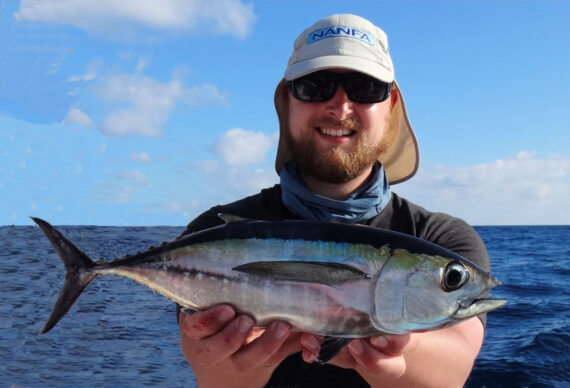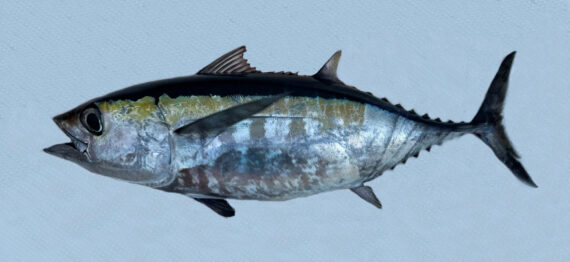Blackfin Tuna, Thunnus atlanticus
 Blackfin Tuna, Thunnus atlanticus. Fish caught from coastal waters off Miami Beach, Florida, December 2013. Length: 60 cm (2 feet 0 inches). Catch, photograph, and identification courtesy of Ben Cantrell, Peoria, Illinois.
Blackfin Tuna, Thunnus atlanticus. Fish caught from coastal waters off Miami Beach, Florida, December 2013. Length: 60 cm (2 feet 0 inches). Catch, photograph, and identification courtesy of Ben Cantrell, Peoria, Illinois.
 Blackfin Tuna, Thunnus atlanticus. Fish caught from coastal waters off Sebastian, Florida, June 2021. Length: 86 cm (2 feet 10 inches). Catch, photograph, and identification courtesy of Ben Cantrell, Sebastian, Florida.
Blackfin Tuna, Thunnus atlanticus. Fish caught from coastal waters off Sebastian, Florida, June 2021. Length: 86 cm (2 feet 10 inches). Catch, photograph, and identification courtesy of Ben Cantrell, Sebastian, Florida.
 Blackfin Tuna, Thunnus atlanticus. Fish caught from coastal waters off Ft. Lauderdale, Florida, July 2021. Length: 88 cm (2 feet 11 inches). Catch, photograph and identification courtesy of Luke Ovgard, Klamath Falls, Oregon.
Blackfin Tuna, Thunnus atlanticus. Fish caught from coastal waters off Ft. Lauderdale, Florida, July 2021. Length: 88 cm (2 feet 11 inches). Catch, photograph and identification courtesy of Luke Ovgard, Klamath Falls, Oregon.
The Blackfin Tuna, Thunnus atlanticus, is a member of the Mackerel or Scombridae Family, and is known in Mexico as atún aleta negra. Globally, there are eight species in the genus Thunnus, of which six found in Mexican waters, two in the Atlantic, one in the Pacific, and three in both the Atlantic and the Pacific Oceans.
The Blackfin Tuna has an elongated, rounded, fusiform, “tuna-like” body that is aerodynamically designed for speed. Their body is deep dark blue dorsally transitioning to silver on the sides and white ventrally with iridescent patches on the sides. Their anal fin, second dorsal fin, and finlets are dusky-bronze; the finlets have a white border. Their pelvic fins are gray. Their head has small eyes and a small oblique mouth that ends before the center of the eyes and is equipped with small slender conical teeth. Their anal fin has 13 or 14 rays followed by 6 to 8 finlets and is similar to the second dorsal fin; their caudal fin is deeply forked with 2 small keels separated by 1 large keel at its base; their first dorsal fin has 13 spines, the first two spines being the longest with a strong concave upper profile; their second dorsal fin has 14 or 15 rays and is set close to the first and is followed by 7 to 9 finlets; their pectoral fins are long, reaching the origin of the second dorsal. They have 19 to 25 gill rakers on their first arch. They have a band of large scales forming a circle around the body behind their head. The lateral line has a significant dip descending posteriorly to the pectoral fin origin and then ascends below the third and fourth dorsal spine, continuing straight to the caudal keel.
The Blackfin Tuna is found over reefs, in bays and offshore in water temperatures above 21oC (70oF) at depths up to 50 m (165 feet). They are the smallest tuna species, reaching a maximum (fork length) of 1.10 m (3 feet 7 inches) in length and 21 kg (46 lbs) in weight. The males are larger than the females and normally outnumber females by 4 to 1. As of January 1, 2024, the International Game Fish Association world record stood at 22.39 kg (49 lbs 6 oz) with the fish caught in coastal waters off Marathon, Florida in April 2006. They are highly migratory moving to more temperate waters during the summer months. They are found in warm coastal waters close to the coastline seaward from the continental shelf. They feed on amphipods, crabs, various fish, shrimp, squid and stomatopods. They are also known to practice cannibalism. They are known to form large schools mixed in with Skipjack Tuna for feeding. In turn they are preyed upon by dorado, blue marlin, skipjack tuna and various sea birds. They have the ability to escape many predators due to their fast swimming speeds and their strong endurance. Reproduction is oviparous with each female releasing between 270,00 and 1,100,000 eggs annually. Fertilization is external with eggs and larvae being pelagic. Their lifespan varies by location and range from five to eight years.
The Blackfin Tuna is a resident of all Mexican waters of the Atlantic Ocean including the Gulf of Mexico and the east coast of the Yucatán Peninsula in the Caribbean.
The Blackfin Tuna is most likely confused with the Yellowfin Tuna, Thunnus albacares (27-33 gill rakers with yellow finlets).
From a conservation perspective the Blackfin Tuna is currently considered to be of Least Concern with stable, widely distributed populations. They are fished commercially by both commercial and artisanal fishermen via trolling and hand-and-line. Males significant out number females in catch levels. They are also considered to be an important game fish due to their fighting ability and are heavily pursued by recreational anglers.